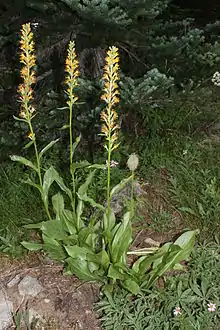Rainiera
Rainiera is a monotypic genus of flowering plants in the daisy family, Asteraceae.[1][2] The single species, Rainiera stricta, is endemic to the northwestern United States (Oregon and Washington). The genus is part of the tribe Senecioneae, and appears to be most closely related to Luina, another genus of northwestern North America, in which it was once placed. Rainiera stricta is of conservation concern, with a G2G3 ranking from NatureServe, and is considered to be globally imperiled. It is known by the common name false silverback.[3]
| Rainiera | |
|---|---|
 | |
| Rainiera stricta in Mount Rainier National Park | |
| Scientific classification | |
| Kingdom: | |
| (unranked): | |
| (unranked): | |
| (unranked): | |
| Order: | |
| Family: | |
| Tribe: | |
| Genus: | Rainiera Greene |
| Species: | R. stricta |
| Binomial name | |
| Rainiera stricta (Greene) Greene | |
Description
Rainiera stricta is an herbaceous perennial with both basal and cauline, alternate, petiolate leaves. It has 30-70 discoid heads arranged in a raceme-like or thyrse-like capitulescence. The disk florets are about 5 per head, and have yellow, sometimes purple-tinged corollas. The cypselae (achenes) are glabrous and have a pappus of white or straw-colored bristles. It is distinguished from Luina by the having fewer florets per head and a racemiform, rather than corymbiform, capitulescence.
Taxonomy
List of species:
Rainiera stricta (Greene) Greene
References
- Flora of North America. "Senecioneae". Family List. 20: 540. Retrieved 2009-08-07.
- Botanic Garden and Botanical Museum Berlin-Dahlem. "Details for: Senecioneae". Euro+Med PlantBase. Freie Universität Berlin. Retrieved 2009-08-07.
- "Rainiera stricta". Natural Resources Conservation Service PLANTS Database. USDA. Retrieved 18 October 2015.